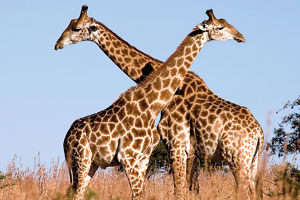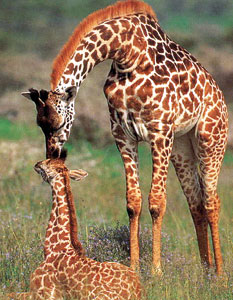The first thing a mother giraffe does is drop her baby on its head.
Coming out of her mother, the baby, known as a calf, falls approximately 6 feet to the hard ground below! Luckily that fall very rarely hurts the baby instead it simply gives the young calf a big thump that forces it to take its first deep breath. Within an hour, the calf is able to stand and walk around. Within a day, it can run, though not as fast as its leggy mother.
For the female giraffe, known as a cow, it’s been a very long pregnancy – 15 months to be exact. (If a baby is a calf and a female is a cow, what do you think a male is called? Though they’re hard to confuse with their shorter, fatter cousins, male giraffes are also known as ‘bulls’.)
To mate with her, the bulls must first
compete. Male giraffes literally go neck to neck, rubbing and twining around each other in an attempt to show the other who’s boss. Often this ‘necking’ is all it takes for one giraffe to know the other is stronger and he will just walk away. If he isn’t
convinced that his rival can beat him though, they begin to fight. Swinging their heads on their long necks, they crash into each other, using their short horns to maximum effect.
A good blow will knock a giraffe back on its feet and may even bring it to the ground. Unsurprisingly, these contests rarely last more than a few minutes – and the loser simply walks away, allowing the victor to mate with the female.
A cow will normally have only one calf – twins are very rare among giraffes. Giraffe calves are born with horns unlike most other baby horned
animals, who will only grow theirs over time. As if in
consideration for their mothers, the babies horns lie flat against their skulls, and will only pop up later,
sometime in their first week of life.
When they know they’re about to give birth, females go to a ‘calving ground’ – a spot used by other giraffes for the same purpose and one this female will use for the rest of her life. This has the happy benefit of
allowing calves who were born around the same time to meet each other. For safety, mothers often leave their calves together in groups known as crèches or nurseries. While the calves hang out, the adults happily feed among trees in the area, with a few females keeping a watchful eye on their young.
Young giraffes, however, have a difficult time. In that first week, a calf is at its most vulnerable. Unlike the tall, strong adults around them, their kicks still lack real strength. Where an adult giraffe can kill a lion with a single well placed kick, a calf has little defence. Many are often taken by hyenas, leopards, and wild dogs and only half will survive those first
challenging six months.
For a calf who survives that long, they’ll have another seven months with their mothers (15 in total) before they are weaned off their mother’s milk. Some, by as young as two months, would have also begun to supplement their diet with leaves.
By this time, the cow might already be pregnant again.
Six foot tall at birth, a giraffe
calf starts to shoot up – growing by as much as 3 centimetres each day
during the first week and doubling their height in their first year.
By the age of one year giraffe calves can measure 10 feet tall. If the calf was a female, she is likely to stay in her mother’s home range when she grows up. A young male giraffe however, will typically leave the herd by the time he is three years old and join a ‘club,’ with other male giraffes. |



